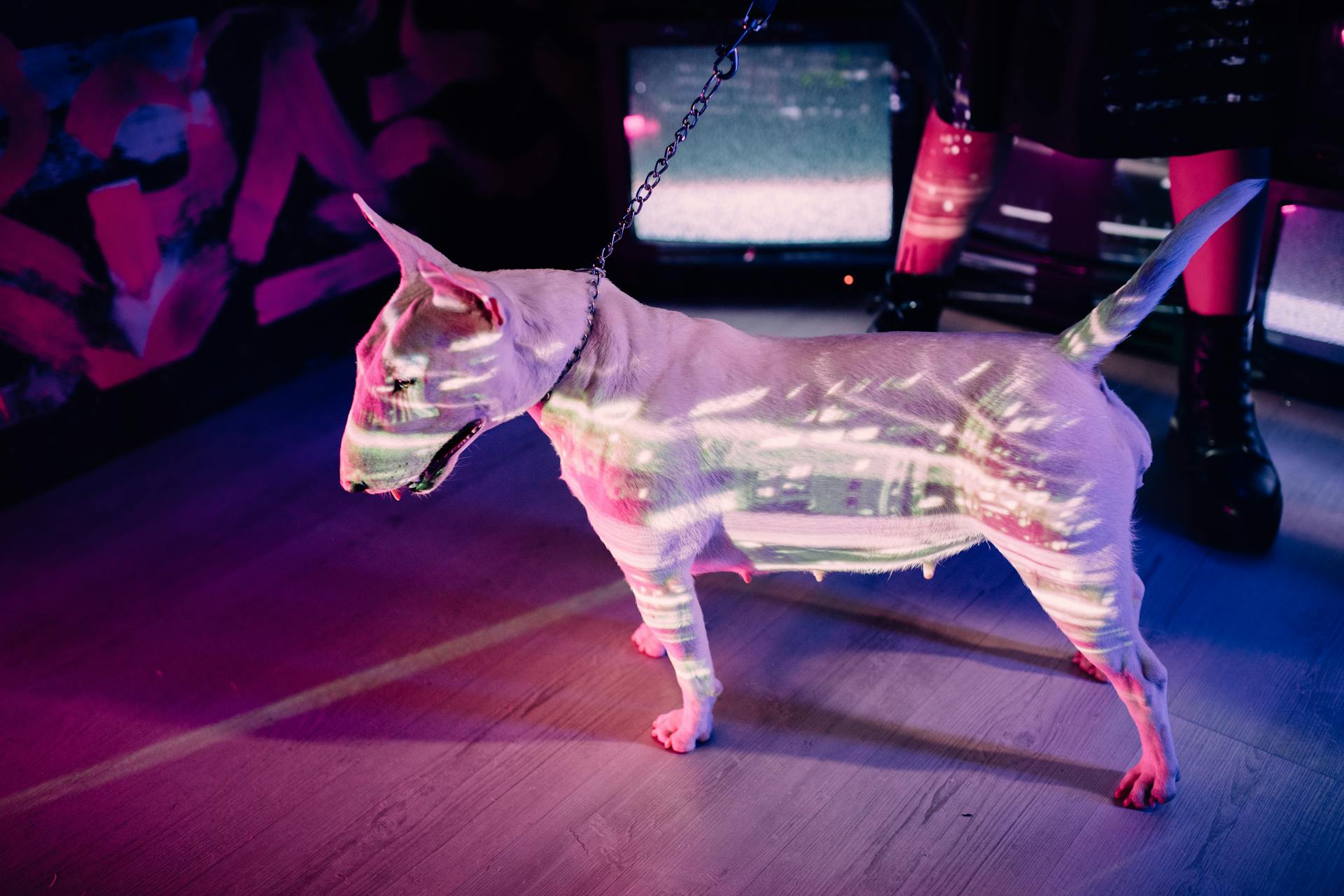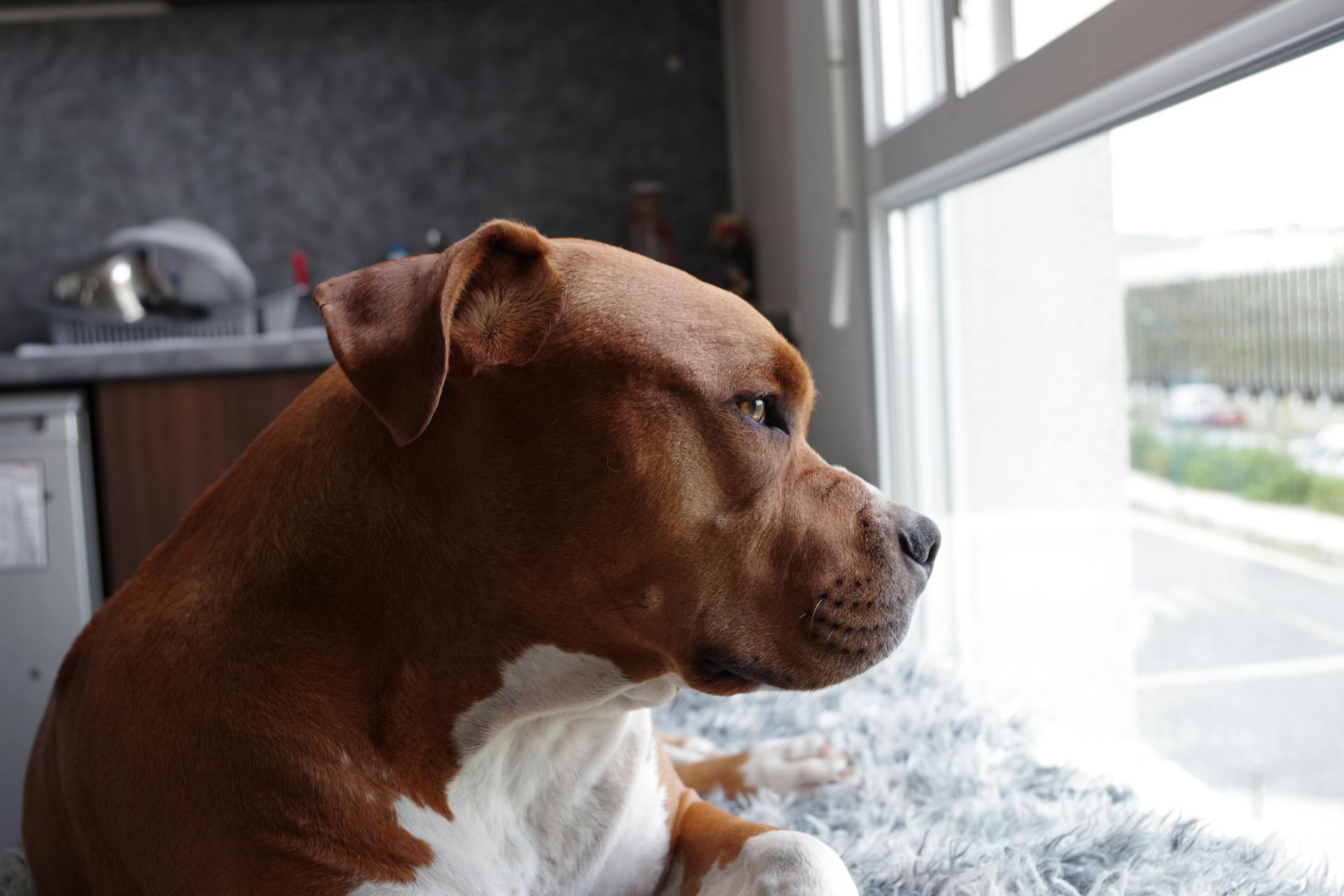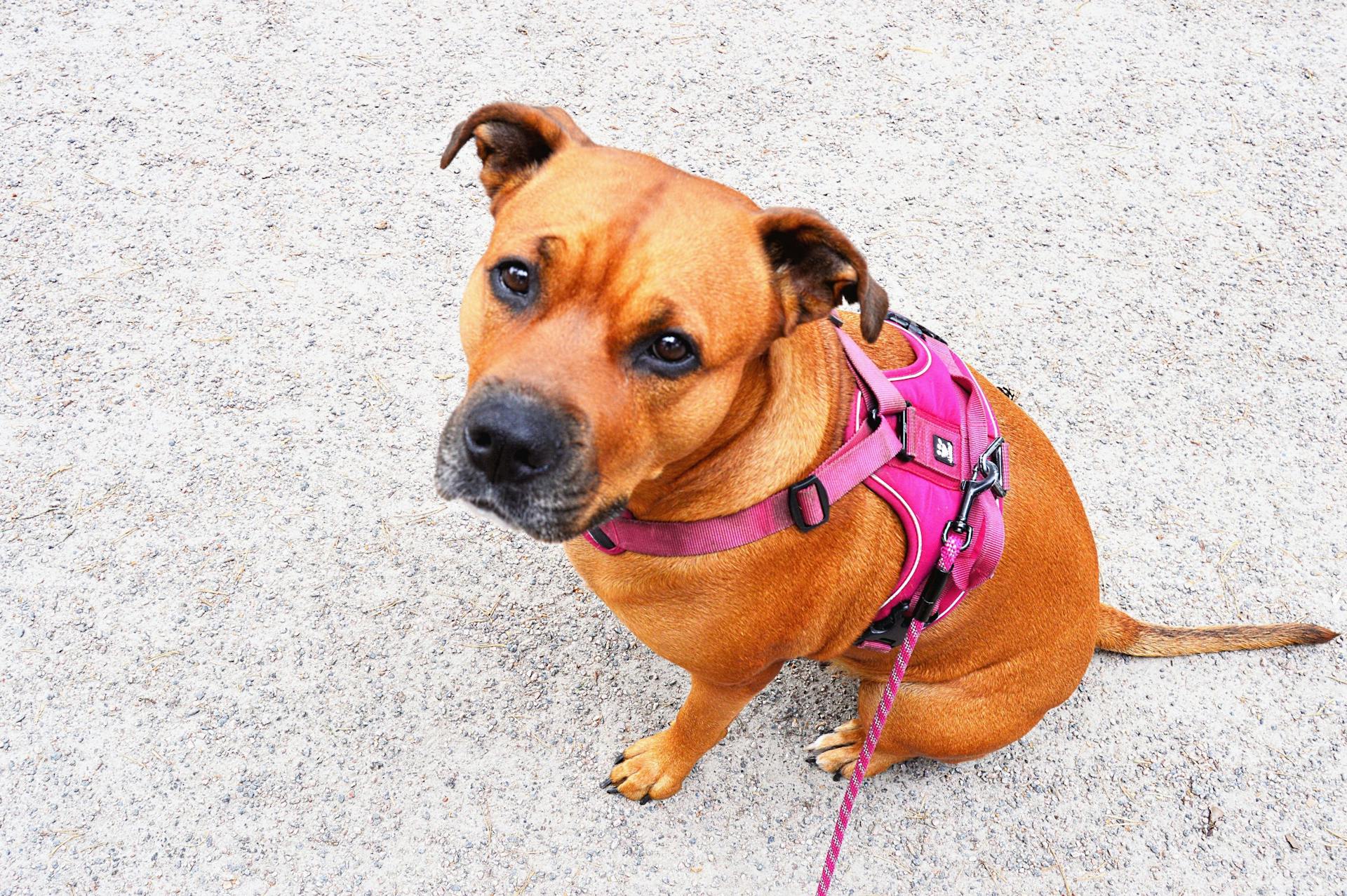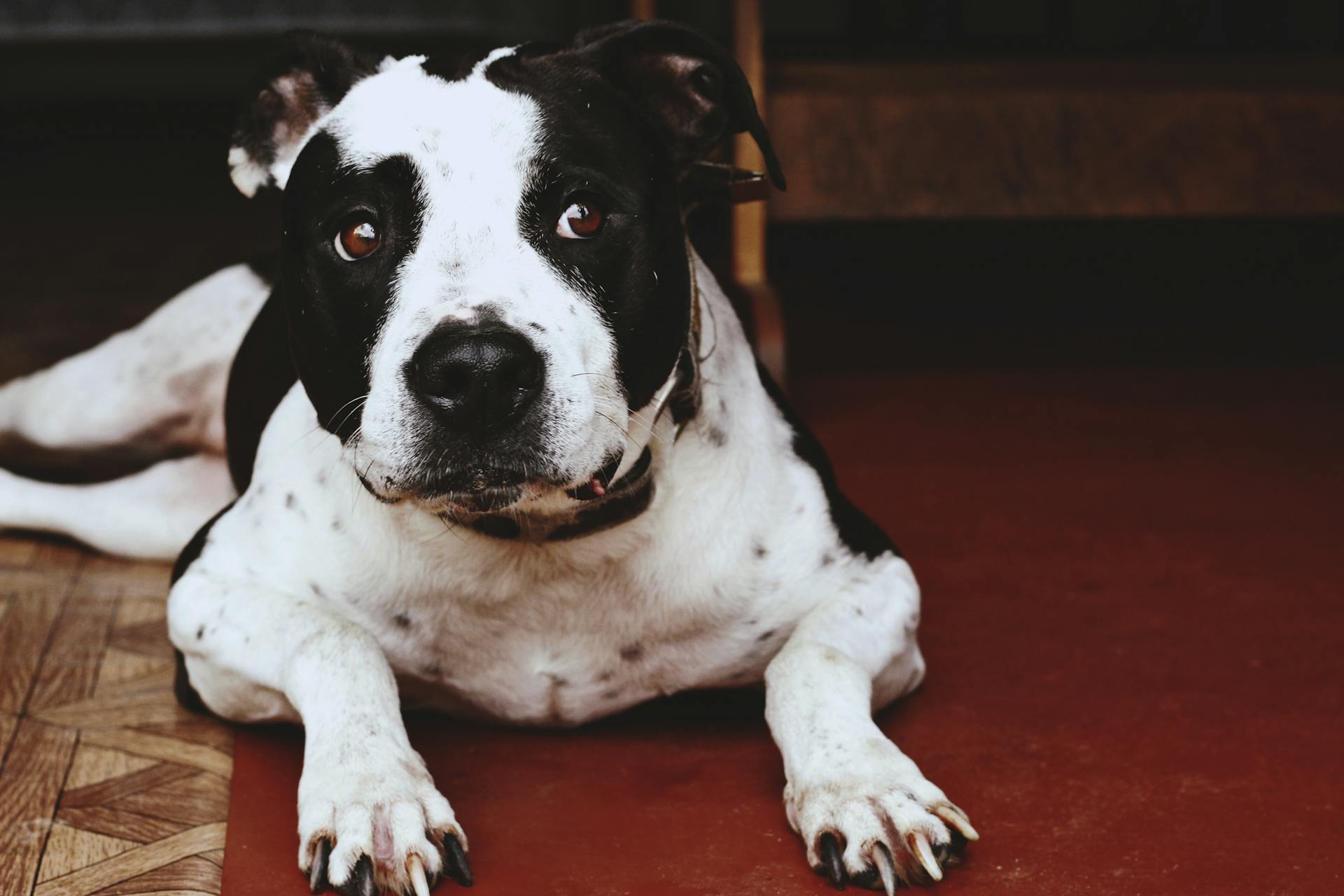
Bull Terrier aggressive behavior can be a major concern for many owners. Bull Terriers are known for their strong prey drive and high energy levels, which can sometimes manifest as aggression towards people or other animals.
This breed's history as a fighting dog has also contributed to their aggressive tendencies. Bull Terriers were originally bred for bull-baiting, a blood sport that involved setting dogs on a tethered bull. Their strong jaw and muscular build made them well-suited for this task.
As a result, many Bull Terriers have a strong prey drive and can be prone to chasing small animals, which can lead to aggressive behavior if not properly managed.
Bull Terrier Basics
The Bull Terrier is a medium-sized dog breed that originated in England in the 19th century.
They are known for their distinctive egg-shaped head and their short, sturdy body.
Bull Terriers typically weigh between 50-80 pounds and stand between 10-14 inches tall at the shoulder.
Their short coat requires minimal grooming, making them a great choice for busy owners.
Bull Terriers are known for their friendly and outgoing personalities, but they can also be strong-willed and independent.
Appearance
The Bull Terrier's appearance is truly one-of-a-kind. Their egg-shaped head is a standout feature, with a flat top and face that curves gently downwards to the tip of the nose.
The nose is black and bent downwards at the tip, with well-developed nostrils that are a key part of their distinctive look.
Their triangular eyes are small, dark, and deep-set, making them a unique feature among dogs. And, fun fact, Bull Terriers are one of the only breeds with triangular eyes!
The body is full and round, with strong, muscular shoulders that give them a sturdy appearance. They have a deep and strong lower jaw that complements their overall build.
Here are some of the different colors you can find in Bull Terriers:
- White
- Red
- Fawn
- Black
- Brindle
- A combination of these
Their tail is carried horizontally, adding to their overall balanced look.
Terrier History
The Bull Terrier's history is a fascinating one. The breed was developed in the 19th century to satisfy the need for vermin control and animal-based blood sports.
Bull and Terriers were created by crossing Old English Bulldogs with Old English Terriers, and possibly other terriers. This new breed combined the speed and dexterity of terriers with the tenacity of Bulldogs.
The Bull Terrier's ancestors were bred for performance, not appearance, which led to the breed dividing into the ancestors of Bull Terriers and Staffordshire Bull Terriers. These early dogs were smaller and easier to handle than their progenitor.
James Hinks started breeding Bull and Terriers with English White Terriers in the mid-19th century, looking for a cleaner appearance with better legs and a nicer head. He achieved this by breeding with Dalmatian, Spanish Pointer, and Whippet to increase elegance and agility.
The first modern Bull Terrier, "Lord Gladiator", was recognized in 1917, and it was the first dog with no stop at all. This marked a significant departure from the breed's earlier appearance.
Bull Terriers were initially bred in all-white, but due to medical problems associated with this, breeders began introducing color in the early 20th century.
Readers also liked: English Bulldog Ancestry
Care and Upkeep
Bull Terriers need a secure fenced yard to exercise in, and they require a lot of human interaction through games, training, and leashed walks.
They don't do well in dog parks because they can be aggressive with unfamiliar animals.
The breed is generally healthy, but common ailments include patellar luxation and mild heart issues.
Care and Upkeep
The Bull Terrier needs a secure fenced yard to exercise and play. This breed requires a lot of human interaction, so be prepared to spend time with your Bull Terrier.
A secure fenced yard is essential for Bull Terriers, as they can be aggressive with unfamiliar animals. This is why dog parks may not be the best option for this breed.
Bull Terriers enjoy many competitive activities, including agility, obedience, and scent work. They also excel in activities like coursing, flyball, and weight pulling.
Bull Terriers don't do well in extreme cold or heat, so be mindful of the weather when exercising your dog. This is especially true for their short coat, which doesn't offer much protection.

Coat care for Bull Terriers is minimal, consisting of occasional bathing and brushing. Regular grooming will keep their coat looking its best.
Bull Terriers are generally healthy, but common ailments include patellar luxation and mild heart issues. Kidney failure is also a concern for this breed.
It's essential to determine if a Bull Terrier puppy has hearing issues before labeling it as disobedient. Deafness is a common problem in Bull Terriers, especially in the white-coated variety.
Diet and Nutrition
Fresh water should always be available to your dog. Make sure to provide a clean and easily accessible water source at all times.
A quality, nutritionally balanced canine diet is essential for your dog's overall health. This includes feeding a diet that meets your dog's individual needs.
Bull terriers require adequate calcium to support their bone development, especially when they are puppies. This is crucial for their growth and development.
Feeding two measured meals per day is a common approach to prevent overfeeding. However, it's always best to consult with your vet to determine the right diet and amount for your dog.
A unique perspective: Bernese Mountain Dog Feeding Chart
Temperament and Behavior
Bull Terriers are generally sweet and good-natured, but may be aggressive around other dogs. They're energetic, huggable, and exuberant, with a comical and mischievous side.
Socialization is key to avoiding aggression in Bull Terriers. Get your puppy exposed to as many social situations as possible, and supervise interactions with young children and other pets. The sooner you start, the more well-mannered your Bull Terrier will become.
A non-socialized Bull Terrier can become problematic and even aggressive in certain situations. Without proper socialization and training, they may become strong-willed and stubborn. They're intelligent, but may push boundaries without training, making them a challenge for first-time dog owners.
Here are some key personality traits to keep in mind when considering a Bull Terrier:
- Intelligent and willing to push boundaries without training
- High energy
- Jealous, clingy, and possessive of the owner and family
- Strong-willed and often stubborn
Terrier Breed
The bull terrier is a breed of dog developed in 19th-century England from several other breeds, including the bulldog and the white English terrier.
Bull terriers require a fair amount of exercise each day. This is essential for their overall health and well-being.
Their minimal grooming needs make them a great choice for busy owners.
Temperament
The temperament of a Bull Terrier is a unique blend of traits that can make them a wonderful companion for active families. They are generally sweet and good-natured, but may still be aggressive around other dogs.
Bull Terriers are energetic, huggable, and exuberant, which means they require regular exercise and mental stimulation to prevent boredom and destructive behavior. They can be comical, mischievous, and stubborn at times, making them a fun but challenging breed to own.
Socialization is key to preventing aggression in Bull Terriers, and it's essential to start early. Exposing your puppy to various social situations, including interactions with children and other pets, can help them become confident and well-mannered.
Here are some common personality traits of Bull Terriers:
- Intelligent and willing to push boundaries without training
- High energy
- Jealous, clingy, and possessive of the owner and family
- Strong-willed and often stubborn
It's essential to remember that every dog is an individual, and while these traits are common in Bull Terriers, they may not apply to every single dog. With proper training, socialization, and care, your Bull Terrier can thrive and become a beloved member of your family.
Aggression and Training
Bull terriers can be stubborn when it comes to training, but they are highly intelligent and respond best to positive reinforcement methods.
They tend to form bad habits if left untrained, so it's essential to start training them young. Proper obedience training and socialization are key to managing your bull terrier.
Positive experiences can go a long way in ensuring your bull terrier is well-mannered, but some bull terriers have a difficult time being comfortable around other dogs, especially unfamiliar ones.
Fear can cause aggression in bull terriers, just like any other dog breed. A bull terrier may show aggression if they are scared or backed into a corner.
Socialization is essential for all dog breeds, including your bull terrier. Get your bull terrier exposed to as many social situations as possible from a young age.
If left untrained and unsocialized, bull terriers may exhibit aggression. A properly socialized bull terrier, on the other hand, is not dangerous.
If this caught your attention, see: Are Pit Bulls Bred for Aggression
Playing tug of war with your bull terrier can be an effective way to release any aggression in a controlled environment.
End each tug of war session on a positive note to keep your bull terrier engaged. Giving a vocal "ouch!" when your bull terrier bites can help deter them from thinking it's all in play.
Ignoring the problem of aggression in your bull terrier is not a solution. If your bull terrier is becoming a biter, address the issue promptly.
Seek the help of a professional trainer if you're unsure of how to react to your bull terrier's aggression. Don't make the situation worse by trying to train them without proper guidance.
Health and Safety
Bull terrier aggressive behavior can be a serious concern for dog owners. A study found that 40% of bull terriers are prone to aggression due to their breeding history.
Bull terriers were originally bred for bloodsports, which can lead to a higher risk of aggression. This breeding history has been linked to the development of certain personality traits.
See what others are reading: Lancashire Heeler History
Bull terriers require regular exercise and mental stimulation to prevent boredom and frustration, which can contribute to aggressive behavior. A minimum of 30 minutes of exercise per day is recommended.
A well-structured training program can help to address aggression in bull terriers. Positive reinforcement techniques, such as clicker training, can be an effective way to teach good behavior.
Bull terriers can be sensitive to noise and stress, which can exacerbate aggressive behavior. Providing a calm and stable environment is essential for their well-being.
Discover more: Bernese Mountain Dog Exercise
Terrier-Specific Issues
Bull terriers are prone to certain issues that can contribute to aggression, including a genetic predisposition to bite inhibition and a high energy level that can lead to frustration if not properly exercised.
Their short coats require minimal grooming, but they can be prone to skin issues, such as fold dermatitis and allergies, which can lead to irritation and aggression.
Bull terriers are generally intelligent and trainable, but they can be stubborn at times, requiring consistent and positive reinforcement training.
Their compact size and energetic nature make them well-suited for apartment living, but they still need regular exercise to prevent boredom and frustration.
Bull terriers are generally good with children, but as with any breed, proper socialization and supervision are crucial to ensure a harmonious household.
Understanding Aggression
Bull Terriers may not be the best dogs with other dogs due to their territorial and protective nature. Aggression can be an issue if you adopt a Bull Terrier.
Fear can cause aggression in Bull Terriers, just like in any other dog breed. Bull Terriers may show aggression if they're scared or backed into a corner.
Aggression is not common in Bull Terriers, but it may present itself if they're not properly socialized. This means they need an owner who's willing to provide love, training, and affection to help them become a well-behaved dog.
Their large muscular build can be intimidating, but it's not a reason to assume they're aggressive.
Home and Social Dynamics
Socialization is key to preventing aggression in Bull Terriers. Get your Bull Terrier exposed to as many social situations as possible as a young puppy.
You should supervise interactions between your Bull Terrier and young children, and socialize them with each other right away to avoid aggression. The more your Bull Terrier gets around these situations, the more comfortable they will be in the future.
Bull Terriers are very smart dogs and can become assertive and possessive if not properly trained. Take charge and provide training, discipline, and love to establish a healthy relationship dynamic in the home.
Home Relationship Dynamic

Bull Terriers are very smart dogs, and if you give them an inch, they will take it. They thrive on structure and clear boundaries.
To avoid aggression, it's essential to take charge and provide training, discipline, and love. This helps establish a healthy relationship dynamic in the home.
Bull Terriers can be assertive and possessive, so it's crucial to set clear rules and expectations from the start. This will prevent them from thinking they run the house or have the final say in every situation.
Socialization is also key in establishing a well-mannered Bull Terrier. Get your puppy exposed to as many social situations as possible, especially with young children and other pets in the household.
Social Isolation
Social isolation can have a significant impact on a dog's behavior, especially if they're not used to being around other animals. A lack of socialization can lead to problematic behavior in dogs, such as aggression around young children or other animals they're not familiar with.
For your interest: How to Train Pit Bulls to Not Be Aggressive

For example, a non-socialized Bull Terrier can become aggressive in certain situations, which is why it's essential to socialize your dog from an early age.
Social isolation can also affect a dog's ability to interact with other dogs, as seen in the case of the author's Jack Russell, who struggles to play nice with other female dogs despite being extremely socialized.
Featured Images: pexels.com


